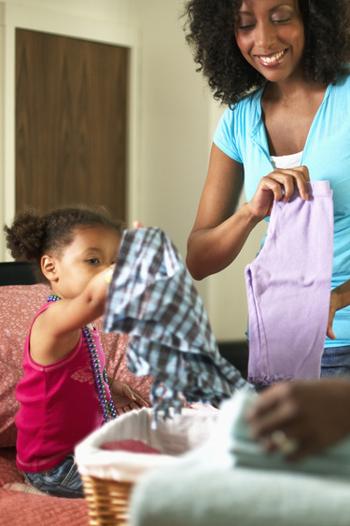Where do the clothes go?
Duration/age

The washing is dry and now it is time to put it away. You could ask your child to help you sort the washing into different piles. Start by asking your child to find their own clothes.
Let’s start by sorting the socks first. Can you find all of your socks?
As you sort through the basket of washing, talk about the different types and sizes of clothing. Explain to your child that the size can help you to work out who it belongs to.
Dida is the biggest person in our family. His jeans are a lot bigger than Benny’s jeans.
Jada and Sienna wear different sized dresses. Sometimes Jada can wear Sienna’s dress because she is smaller but Sienna is too big to fit into Jada’s dress.
Are there different styles of clothing that family members wear? Can your child remember who likes to wear what?
Materials you will need
- A basked of clean washing
Alternative tools
- Smaller tubs for sorting the washing
Skills this activity improves
Why does this matter?
Sorting the washing helps children to understand that there are different ways that we can describe, group and classify clothing. We can sort the washing by size, type of clothing, who the clothing belongs to or by season.
Sorting helps children to notice the different attributes of an object and that we use these attributes to describe them.
When your child helps you to sort the washing they are listening to instructions, using size and colour and patterns. Listening to and following instructions helps your child to develop mathematical language and to understand that language helps us to know what to do.
What does this lead to?
Sorting and classifying by different attributes helps children to make decisions about how to use resources and choose which technique or process will work best.
Sorting, grouping and classifying helps children to develop skills in noticing and describing what they see.
By helping to sort the washing your child is learning to listen carefully to what is being said and to follow directions. As they listen and respond to what you say they are learning how to give directions and instructions to another person.
Language to use
- Colour, light, dark, white
- Socks, pants, underwear, jeans, shirt, jumper, PJs, dress, skirt, tights, bathers
- More, less, most, few, some, pair
- Winter, summer
- Day time, night-time
- School uniform, sports uniform, casual clothes, good clothes
- Old clothes, new clothes
- Big, little, smaller, larger, medium
- Size
- Pattern
- Boys clothes, girls clothes, gender neutral, adult clothing, children’s clothing, baby clothes
Questions to use
- Which pile of clothing is bigger?
- Who has the most washing?
- Why are there pairs of socks?
- Can your brother wear your sister’s pants?
- Can people who aren’t the same age wear the same sized socks?
Useful tips
- You might also like to take a look at the activities Hanging up the washing and Sorting the washing ready to wash.
- Younger children need shorter instructions.
- When sorting start with only one attribute, like size.
- Remember to talk to your child in your home language.
More ideas
- Create sorting baskets to put the clean washing in. You could place a photo of each family member on the front to help your child know where to put each person’s clothing.
- Read the story Washing Line by Jez Alborough.
Variation by age
Birth to two year olds
- Ask your child to find the partner to each sock.
- Ask your child to find their clothes in the basket.
Three to five year olds
- Sort the washing into boys and girls clothes.
- Ask your child to find the partner to each sock.
- Ask your child to find their clothes in the basket.
Questions to ask
- Which is bigger?
- Which is smaller?
- Which one is the same?
Questions to ask
- Which is bigger?
- Which is smaller?
- Which one is the same?
- Would a boy wear a dress?
- Can a girl wear boys clothing?
- Are there clothes both boys and girls can wear?
Language to use
- Same, different, matching
Language to use
- Same, different, matching, partner, pair
- Boys, girls, unisex


